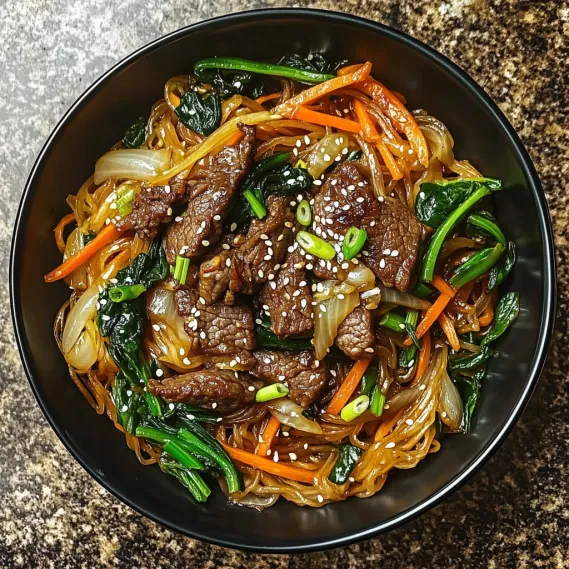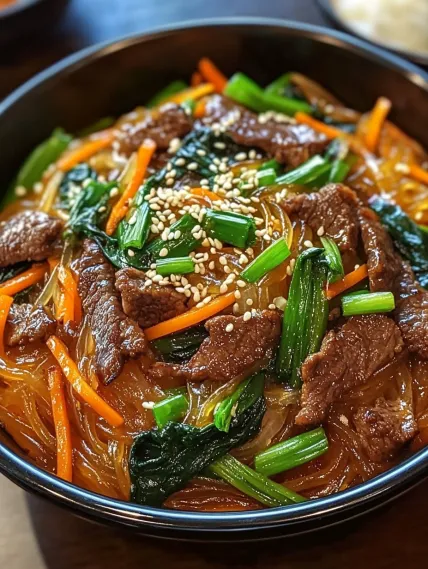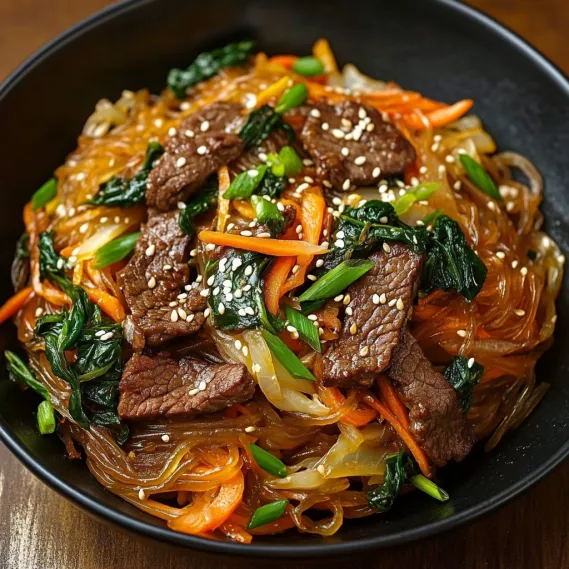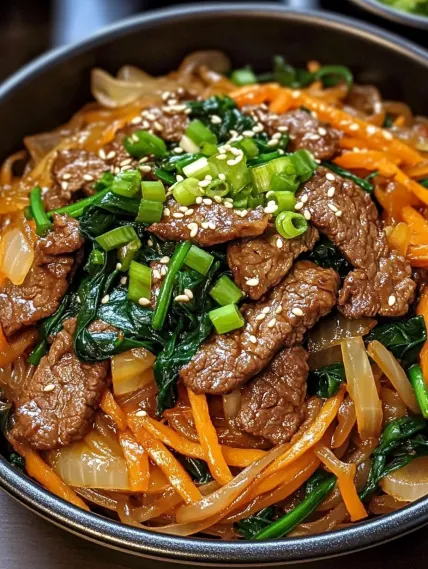 Pin it
Pin it
Sweet potato glass noodles mingle with soft beef strips and bright veggies in Korean japchae, creating the perfect mix of chewy and crunchy textures. The noodles have a springy bounce that pairs wonderfully with the crisp-tender vegetables and juicy beef, all wrapped in a shiny sauce that's rich with nutty sesame oil and savory soy flavors. The rainbow of julienned carrots, fresh spinach, and thinly sliced onions makes this dish catch your eye instantly while packing it with flavor and nutrients that'll introduce you to genuine Korean cooking at its finest.
After coming home from Seoul completely hooked on japchae, my kitchen turned into a test lab. My first try? Total flop - mushy noodles and veggies cooked to death. It took a bunch of attempts and some coaching from my Korean buddy before I got the hang of cooking each part separately then mixing everything at the end. Now when friends come over, this is my showstopper dish, and they can't believe how much flavor comes from such basic ingredients.
Key Ingredients and Shopping Advice
- Sweet Potato Glass Noodles: These see-through noodles are what makes this dish special. You'll find them at Asian markets or online shops. Don't swap them for rice or wheat noodles - you won't get that signature bounce and chew.
- Beef: Go for thin-cut ribeye or sirloin. Pop the meat in the freezer for 20 minutes before slicing to get super thin pieces that cook quick and stay tender.
- Vegetables: Mix it up with bright carrots, fresh spinach, and sliced onions. Cut everything about the same size so they cook evenly and look nice together.
- Sesame Oil: This nutty oil brings that unmistakable Korean flavor. Make sure you get pure sesame oil, not mixed versions.
- Soy Sauce: Forms the tasty base of your sauce. Pick low-sodium if you're watching your salt.
Spending a few extra bucks on really good sesame oil totally transforms this dish. The deep, toasty smell of quality oil spreads through the whole thing and nails that authentic Korean taste that'll have everyone asking for more.
Step-by-Step Cooking Method
- Step 1: Cook the Noodles
- Get a big pot of water boiling. Toss in the sweet potato noodles and let them cook for 5-6 minutes until they're soft but still bouncy. Don't let them go too long - they should fight back a little when you bite them. Drain and run cold water over them to stop them cooking more.
- Step 2: Get the Beef Ready
- Mix your thin beef slices with soy sauce, sesame oil, and brown sugar in a bowl. Let them soak up the flavors for 10 minutes while you deal with the other stuff. Heat up a big pan or wok really hot and cook the beef until it browns. Set it aside when done.
- Step 3: Handle the Veggies
- Using the same pan, add some olive oil. Cook each veggie on its own: carrots first until they soften a bit, then onions until you can see through them, then garlic, and finally spinach just until it shrinks down. Take each one out when it's done.
- Step 4: Mix Up the Sauce
- In a small bowl, stir together the rest of your soy sauce, sesame oil, and brown sugar until the sugar melts away. This balanced mix will coat everything with that addictive sweet-savory combo that makes japchae so good.
- Step 5: Throw It All Together
- Put the noodles back in the pan over medium heat. Pour your sauce all over and toss until they're all coated. Add in your cooked beef, veggies, and green onions, gently mixing everything until it's all warmed through.
- Step 6: Final Taste Check
- Give it a taste and add salt if needed. Everything should taste rich and balanced, with tender noodles and flavorful beef.
 Pin it
Pin it
When I made this for my daughter's graduation bash, I couldn't believe how many Korean guests came up to tell me it tasted just like their mom's cooking. My secret wasn't fancy - I just cooked each veggie on its own to keep the colors bright and textures just right, then let everything sit together for an hour before serving so all those flavors could get to know each other.
 Pin it
Pin it
Amazing Adaptations for Japchae
Japchae can shift from simple side to main event with just a few tweaks. I've found mushrooms make it even better - especially shiitakes with their meaty feel and deep flavor that pairs so well with the sweet-savory sauce. During hot months, I throw in some sliced bell peppers for extra snap and color. When feeding a crowd with different food needs, I'll make a big batch of the noodles and veggies, then put out protein options on the side - beef, chicken, shrimp, or tofu. This mix-and-match approach has turned into a monthly thing at our house, with everyone building their perfect bowl just how they want it.
Getting Those Noodles Just Right
It took me a bunch of tries to figure out sweet potato noodles. They're not like regular pasta - they keep soaking up liquid long after you cook them, which can turn them into mush if you're not careful. My big breakthrough was cooking them just until they had a little bite left, then cooling them right away under cold water. A quick toss with sesame oil stops them sticking together and starts building flavor from the get-go. When I add the sauce later, I just warm everything through instead of letting it simmer, which keeps the noodles springy instead of soggy. My husband used to be all about rice dishes but now asks for japchae all the time, specifically because the noodles have that perfect chewy texture.
Making Flavors and Colors Work Together
Korean cooking is big on balance - not just how things taste but how they look and their health benefits too. They call this idea 'banchan.' I've taken this approach with my japchae, making sure each veggie brings both flavor and visual pop to the plate. The deep spinach greens, bright orange carrots, and purple-white onions don't just look pretty - they signal all the different nutrients packed in there. Even my son who usually picks vegetables out of everything eats his japchae completely clean - the flavors blend so well that every bit seems necessary to the whole experience. When I teach cooking at our community center, japchae has become my favorite example of how thoughtful prep makes food both beautiful and delicious.
Food as a Cultural Bridge
Making japchae has grown beyond just cooking something tasty - it's opened up Korean culture for our whole family. After learning this dish started as royal court food during the Joseon Dynasty, we got curious about other Korean traditions and history. Now we celebrate Korean holidays like Chuseok (their harvest festival) with japchae as the main attraction. My kids have learned about why the colorful presentation matters - it stands for harmony and good luck. What began as just trying a new recipe has turned into real appreciation for another culture, with Korean cookbooks taking up prime shelf space in our kitchen and Korean TV shows becoming our Friday night family tradition.
Chef's Helpful Tips
- Get everything cut and ready before you start cooking - this dish moves fast once you begin
- Sprinkle toasted sesame seeds on top just before serving for extra crunch and nutty flavor
- When feeding a crowd, prep all the parts ahead and mix them just before everyone eats
- Want some heat? Add a spoonful of gochujang (Korean chili paste) to your sauce
- If serving as your main dish, bump up the meat to 2.5-3 pounds for 10 people
I found out how important it is to let the finished dish rest after my first try ended up a bit dry. Those extra few minutes make all the difference in how creamy and moist the final result turns out.
Wallet-Friendly Meal Ideas
This recipe shows how smart cooking can turn basic ingredients into something special, especially when you grab chicken or steak on sale. I stock up on cube steak whenever it's marked down, portioning and freezing it just for this dish. Most other ingredients keep forever in your pantry, so you can whip up restaurant-quality food for way less than takeout would cost you.
Tweaks for Picky Eaters
Homes with different food preferences will love how easy this dish adapts. Kids who turn their nose up at certain veggies often gobble this up since the pasta soaks up that savory mushroom flavor. A sprinkle of cheese on top wins over the pickiest kids, or mix in easy veggies like peas or corn to sneak in more nutrition. Think of the basic recipe as your starting point - change it up to make everyone at your table happy.
Using What's in Season
This flexible main dish welcomes whatever produce looks good throughout the year. Summer brings fresh corn or zucchini options. Fall calls for hearty butternut squash or mushroom varieties. Winter versions work great with root veggies. Spring lets you toss in tender asparagus tips and fresh peas. These changes keep meals interesting all year while using what's fresh and cheap at your store.
Time-Saving Prep Ideas
Busy families will love how this dish fits into hectic schedules. You can make the pasta and sauce up to three days ahead and keep them in the fridge. For longer storage, the whole finished dish freezes well for up to three months. When you're ready to eat, just thaw it in the fridge overnight before baking as directed, adding just 1-2 minutes to your cooking time.
Chef's Essential Tips
- Kick up the flavor by adding a teaspoon of thyme or rosemary to your mushroom mix
- Give potato chips a quick toast before using them for extra crunch
- Spice lovers can add a dash of cayenne pepper to the mushrooms
- For thicker sauce, mix 1 tablespoon cornstarch with 2 tablespoons cold water and stir it in during the last 5 minutes
- Leftovers taste even better the next day as flavors continue to blend
I figured out these little tricks after making this dish many times - especially the rosemary addition, which adds amazing depth without making people say, "Hey, is that rosemary?"
 Pin it
Pin it
This go-to tuna noodle dish has become my dinner hero when I need something everyone will eat. The mix of soft pasta, smooth sauce, and crunchy chips creates something magical - a meal that feels like comfort food but comes together without any fuss.
This tuna casserole shows that amazing food doesn't need fancy methods or weird ingredients - just good basics put together with care to create something truly satisfying.
Frequently Asked Questions
- → What are sweet potato noodles, and how can I get them?
- Made with sweet potato starch, these chewy, bouncy noodles (dangmyeon) are perfect for Japchae. Look for them online or at Asian or Korean food stores, often labeled as 'glass noodles.'
- → Can I skip the beef in Japchae?
- For sure! Just leave the beef out and load it up with extra veggies like zucchini, mushrooms, or bell peppers. Tofu is also great for adding protein, and the sesame soy base still tastes amazing.
- → What’s the best way to store leftovers?
- Pack the noodles in an airtight container and keep them in the fridge for 3-4 days. To reheat, mix in a bit of sesame oil and soy sauce to revive the flavors, as the noodles soak up the sauce over time.
- → Why do my noodles stick together?
- Sticking happens when noodles overcook or sit too long after boiling. Rinse with cold water straight after cooking and toss them lightly in sesame oil. Only add them in when the stir-fry is almost done.
- → Is this dish good for make-ahead meals?
- Totally! Let the dish sit overnight to let the flavors meld, and it serves great at room temperature. Add a drizzle of sesame oil before serving to freshen it up.
